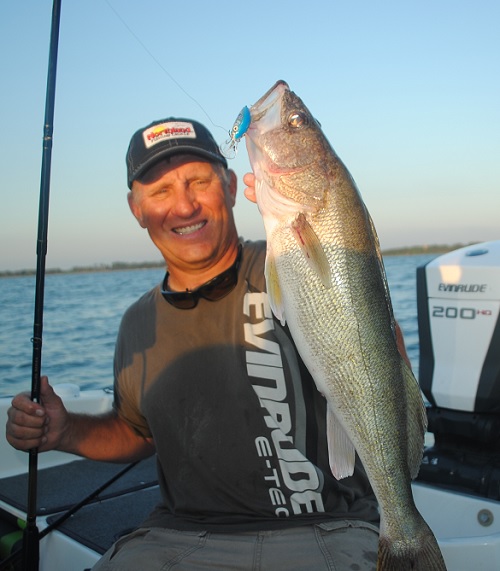 There are lots of things an angler can do to put more fish in the boat, but I truly believe there are two things we need to do to consistently catch more fish. First, we’ve got to find the fish. That has become easier and easier as sonar technology improves. Today’s sonar is just outstanding, a huge improvement over the sonar I used when I started fishing.
There are lots of things an angler can do to put more fish in the boat, but I truly believe there are two things we need to do to consistently catch more fish. First, we’ve got to find the fish. That has become easier and easier as sonar technology improves. Today’s sonar is just outstanding, a huge improvement over the sonar I used when I started fishing.

Truthfully, it’s tough for the fish to hide. I run Raymarine sonar on my boat and have been truly amazed at its ability to separate targets. I can see walleyes hiding among the rocks. At least I think I can.
Next, now that we’ve found the fish, we need to present a bait to them. That’s where “Leveling with the fish” comes in. We’ve got to present the bait to the fish at a level at which they’ll eat it.
A very memorable fishing trip comes to mind when I think of the importance of presenting the bait at the level where the fish are.
The trip in mind took place on Big Sand Lake near Minaki, Ontario. We were fishing the Gary Roach Invitational Walleye Tournament. This was as least twenty five years ago, back in the days when we all knew that walleyes lived and ate right on the bottom. If you weren’t getting snagged, you weren’t fishing right, or at least we thought.
There’s an area in Big Sand Lake that is very deep, over one hundred feet deep if I remember correctly. On one of the practice days, a couple of us were looking for deep structure in this area and noticed a lot of fish activity about twenty feet below the surface over that really deep water. We thought the sonar was acting up or something and just kept looking for that deep structure. After a while however, we decided we needed to try to find out what those things were suspended so far above the bottom. We tied our deepest running crankbaits to six pound test line and long, limber rods. The light line enabled the baits to run deeper because light line has less diameter, therefore less water resistance, which enabled the bait to go a bit deeper than it would on ten or twelve pound test line. Our baits were running about fifteen feet below the water’s surface. Since the water was clear, the fish could see them better and would move up to take the lure.
The soft action rods prevented the light line from getting broke. With a heavier action rod, the line would break when a fish hit. With the soft action, the rod just bent more. During that tournament I never broke a line and never lost a fish.
We trolled not too far and got bit: Nice walleye, much larger than average. The walleyes were suspending in the area because the baitfish were there, and the baitfish were probably there because the oxygen levels or water temps any deeper weren’t what they wanted. I’m not exactly sure why the fish were there, but I know I cashed a nice check because I put my bait right there in the fish zone.
It doesn’t matter what kind of fish you’re after, if you put your bait at their level, or better yet, just a bit above them, you’re going to catch more fish.
To see all the most recent episodes of Fishing the Midwest television, new fishing related video tips, and fishing articles from the past, visit fishingthemidwest.com If you do Facebook, check us out for a variety of fishing related things.
PHOTO CAPTION—On a fishing trip this past summer, Mike Frisch and Bob Jensen pulled Salmo Hornets eight feet below the surface over seventeen feet of water to catch walleyes like this one.
